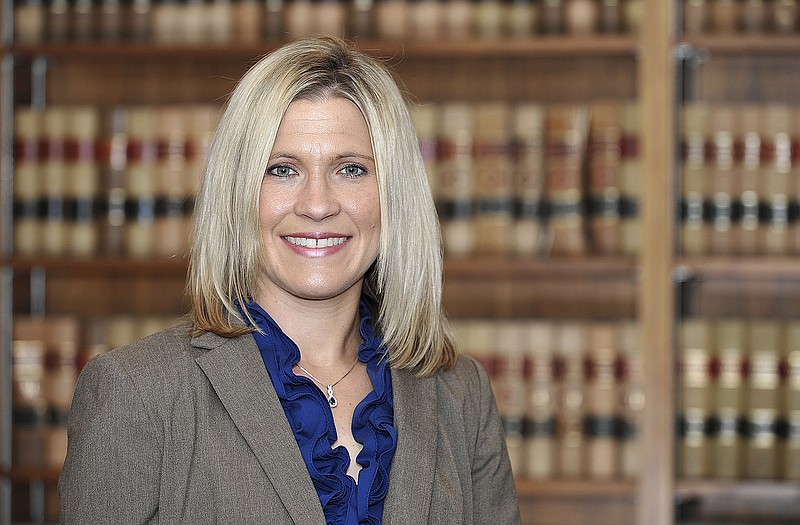Sebrina Barrett is only the third person to be the Missouri Bar's executive director in the last 55 years.
She's been the director for almost 18 months, but spent another nearly two years as the deputy director, learning the top job from Keith Birkes before he retired from a 27-year career.
Birkes had succeeded Wade Baker, who also served 27 years.
Barrett, 36, isn't ready to predict how long she'll stay in the post.
"We'll see," she said last week. "Twenty-seven years seems so long - but I can't believe I've been here three years, already."
Barrett, a native of Walnut Grove in Greene County, was working for the New York State Bar when the opportunity came to apply for a job back in her home state.
The chance to move her growing family closer to her parents was one she couldn't pass up.
"It's not something that most of us, when we go to law school, even think about - the possibility of being a Bar association executive," Barrett said. "But, the opportunity was there, and it was a nice combination of my journalism background and my legal background."
The Bar's work also was an important attraction.
"Our mission is to improve the law and advance the administration of justice in our state," she explained. "We see ourselves as providing service to the citizens of Missouri as well as the lawyers."
The bar provides information and education services helping people find lawyers.
"I think the public's biggest misconception is that we provide legal service," Barrett said. "Members of the public call here and think we have lawyers on staff who will help them with their problem."
Bar members also help teachers educate students about the Constitution and the nation's rule of law philosophy.
The Missouri Bar is a "unified" bar - membership is required in order to be licensed to practice law in the state.
"I prefer the unified model because it enables us to, truly, represent every facet of the profession," she said. "A big example of that is the criminal code - because we have such a broad membership, we were able to bring together prosecutors, criminal defense attorneys, public defenders, judges, legislators - everybody.
"Because we could get them together, we were able to come up with a product that will greatly benefit the state and the profession."
Missouri lawmakers this year passed a major reorganization of the state's criminal laws, ending an eight-year process the Bar started.
Barrett noted that process began before she joined the association's head offices, and she sees her role as "more of a shepherd," working with the Bar's committee members and the legislative sponsors to get the bill passed.
"It was a group effort," she explained. "I certainly would not say I did the heavy lifting."
The Bar is headed by a one-year president, who's a lawyer with an active practice.
The executive's and Bar staff's job is to help that president define specific goals and initiatives for the one-year term, then collaborate with that president to move those goals forward during the year.
"It allows for continuity," Barrett said. "Bar presidents are president for such a short time, but there's a real commitment among the officers - as they transition through the steps from vice president, to president-elect, to president - to continue the projects that the presidents before them began, and to carry those through.
"Very few things can be accomplished in one year, so it's really a leadership team that works on projects and takes them through."
The criminal code rewrite was one such project. Missouri's Nonpartisan Court Plan, first approved by voters in 1940, is another that draws her attention regularly.
"I get most frustrated when we are having to defend our court plan from attacks," she said, "because the plan, for over 70 years, has been a model for the nation - and it's working just fine.
"The folks who want to change it want to add politics to the process."
The plan uses commissions to consider applicants for judicial vacancies on the Supreme and Appeals Court, and on trial courts in the St. Louis, Kansas City and Springfield areas, then submit three names to the governor, for his selection of one.
Outstate voters continue choosing judges in partisan elections.
Barrett acknowledged it's easier for opponents to question the plan through sound bites, while supporters often have to remind people that the plan came about because powerful politicians were controlling who became judges in the state.
"In Missouri, when you go up (in court) against an opposing side, you don't have to wonder if anybody in this room has given money to a judge to influence the outcome," Barrett said.
Active in FFA and 4-H during high school, Barrent went to Mizzou as an agricultural journalism major. She then received a scholarship from Southern Illinois University at Carbondale and earned a law degree there.
Her first job after law school was clerking for Missouri Supreme Court Judge Mike Wolf.
During that year, she married Michael Barrett, a fellow law school student and New York state native.
After her year as Wolf's clerk, she moved to Albany and got a job as a judge's clerk on New York's court of appeals - that state's version of the top court.
After that, Barrett spent the next five years working at the New York Bar association.
Barrett enjoys going to work every day, working with people "who are incredibly dedicated" to their jobs, she said. "They make me want to do a better job."
She prefers to think of "challenges" to her job, not things she'd rather not face.
"Lawyers are intelligent, passionate people who often have reasonably different views on any given issue," she said. "Bringing lawyers together from all backgrounds - to the point of consensus on difficult issues - is certainly a challenging part of the job, but it is also rewarding."

